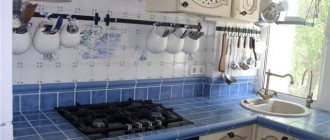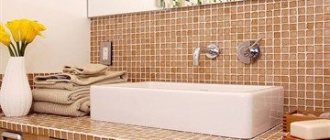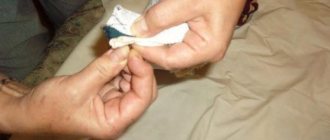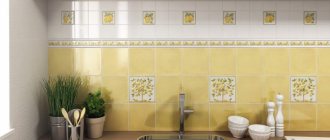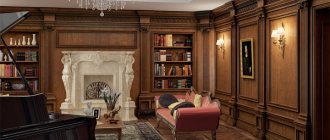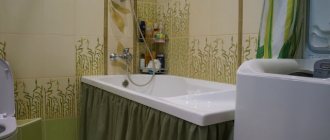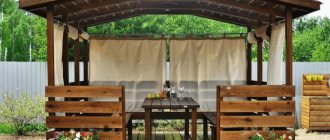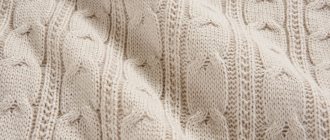Can the space under the bath be left open? Of course, it is possible, but mainly this happens in two cases. Firstly, if the bathtub itself has beautiful figured legs and a neat outer surface, then it is designed for just such an installation. And secondly, if the owners are completely indifferent to what their bathroom or combined bathroom looks like. In other options, a special decorative panel, often called a screen, is mounted under the sides of the bathtub. This is the only way to ensure that a small room for taking water procedures will look aesthetically pleasing - otherwise some kind of incompleteness remains.
DIY bath screen
The modern assortment of construction stores offers a variety of both ready-made solutions and materials suitable for creating such a structure. Choosing the best option, suitable both in terms of the availability of self-installation and external data, can be quite difficult if you do not first figure out what and how you can make a bath screen with your own hands. In addition, when starting work, you should take into account some of the nuances of arranging this specific interior detail, as well as the requirements for its design.
What should a shield be like for a bathroom?
There are a lot of options for what you can do under the bathtub.
They differ from each other in appearance and functions. When selecting manufacturing material and installation method, we usually focus on the following design requirements:
- Moisture resistance
. Considering the fact that the humidity in the bathroom is constantly high, it is recommended to make the screen exclusively from moisture-resistant materials that will not deteriorate in such a microclimate. If this condition is neglected, the fence will begin to accumulate fungus and mold on its surface. There is also a possibility of rotting and destruction of the material under the influence of high humidity and temperature fluctuations. - Airtightness
. To prevent water from the room from getting under the bathtub, it is necessary to create an airtight barrier in its path. - Possibility of access to communications
. It is prohibited to build a completely solid partition under the bathtub, since from time to time the drain and overflow pipe will need maintenance. To do this, the screen is equipped with windows and doors, or it is made sliding.
Most often, a do-it-yourself bathroom screen is made from the following materials:
- Plastic
. The most common option for self-implementation. Plastic partitions are hygienic, moisture-resistant and durable. The construction of such a structure will be very inexpensive, and installation work will take a minimum of time. As a decorative design for the finished screen, you can use a special film, choosing its color to match the overall decoration of the room. In addition, marine-themed stickers look stylish. In addition to single-color designs, sets of plastic panels of various colors are often used. - MDF panels
. They take second place in popularity when creating screens for the bathroom. MDF is chosen in cases where the bathroom is well ventilated, because... This material is not completely moisture resistant. To ensure that such a partition lasts as long as possible, it is additionally coated with a water-repellent composition. Installation work is in many ways similar to the construction of panels for a bathtub from plastic panels. - Plasterboard sheets
. To finish the bathroom, you must use a moisture-resistant type of plasterboard (such sheets have a specific green color). The advantage of gypsum plaster boards is that they can be used to create a very flat base, convenient for tiling, moisture-resistant wallpaper, decorative plaster, painting with moisture-resistant paint, and gluing film. - Wooden panels
. A similar screen is built in bathrooms decorated in country style. To protect the finished structure, varnishing or special hydrophobic impregnations are often used.
Tools
The tool needed for the manufacture and installation of a screen ceiling under a bathtub depends on the material of its manufacture and design features. List of necessary tools for the construction and installation of almost any screens:
- Hammer, a universal construction tool for destroying building materials and drilling holes in wall ceilings necessary for fastening the frame.
- A grinder is required for cutting steel profiles, tiles, and plastic; the retail chain sells special discs that can be used to cut wood.
- When working with drywall, you will definitely need a screwdriver, which significantly speeds up the assembly process.
- A metal level is necessary to accurately position the screen vertically and horizontally.
- Spatulas and trowels, a comb for laying tiles, using brick, plasterboard or gas silicate blocks as a base.
- A tape measure, pencil, paint knife, hammer, and Phillips screwdriver are household tools when installing various types of screen fencing.
Making your own sliding screen
Technological openings and doors for access to communications are made differently. They open vertically (hinged) or horizontally (hinged). Installation requires additional profiles, canopies and a special mechanism for the hinged doors to hold them in a fixed position. In a limited space they are inconvenient - they take up space when opened.
MDF has good properties. The sheet sizes are suitable not only for sliding doors, but also for other types of screens. Due to increased sensitivity to moisture, the panels are pre-treated with a special impregnation, then with a primer. An additional ventilation hole is installed on the side opposite the inspection hatch. Decorate a small opening with a plastic grill.
Screen made of MDF panels with sliding doors
Door guides consist of a special profile along which they move. It has an W-shaped cross-section. It can be made of plastic, but preferably aluminum, which is stronger and holds its shape well. Sold in construction stores that sell furniture components
Install at the top and bottom of the structure, paying special attention to the location in the same plane, otherwise there will be distortions. The same profiles are placed on the sides as spacer posts
With two sliding doors
For the manufacture of doors, materials similar to the main one, or acrylic, are used. It is sold in specialized stores, has a thickness of 5–8 mm and a variety of colors. It is sawed with a jigsaw, then the edges are processed with a file with fine notches. The finished doors are inserted into the guide profiles. Screw on furniture handles and use them.
Sliding panels based on PVC window profiles
Various options for installing sliding screens are possible. It is often divided into three parts: a central fixed one, on one side there is access to sewer pipes, on the other there are shelves for storing small items. If preference is given to doors that move along the entire length, two parts are prepared. The dimensions are calculated so that they overlap each other by several centimeters. Installed in different grooves.
Made from MDF or OSB boards
The principle of manufacturing the frame is indistinguishable from its counterpart, intended for installing gypsum board. The only difference is the need to install additional ventilation slots located on the opposite side of the inspection door. This should be a small slot covered with a plastic grill. Another option is to make neat round holes arranged in random order.
Creation of designs, nuances of technology
There are certain requirements for a homemade product, as well as for factory ones. During the installation process, provision is made for free access to communications. The design must have a door, window, sliding or removable panel. The material is selected in accordance with the room conditions: high humidity and constant temperature changes. Not all finishing materials are suitable; some quickly collapse.
The screen does not serve as a support for the bath; legs are used for this purpose. The free space under the bowl is used as a niche for storing detergents, household chemicals, and various small items, although this is not necessary. You can also install shelves on the outside. This option is especially relevant for small spaces.
Photo
Openwork
Curtain screen
Lattice
Sliding
Original screen
Screen with footwell
Under the bath with a door
Tiled
From mosaic
Wooden screen
Did this article help you?
Types and features of bath screens
The future structure can perform several functions: be a decorative element, serve for storing things, or both at the same time. Depending on the purpose, there are different types:
- 1. Stationary - the simplest and fastest solution. The disadvantage is the monolithic structure. For repairs, small hatches are provided, which is not very convenient. The corner screen is mainly made in this design.
- 2. Removable - the space under the bathroom is not used, but there is access to communications. If necessary, the casing can be easily dismantled and reinstalled.
- 3. Sliding - all pipes are hidden, takes up little space. Allows easy access to sewerage.
- 4. Hinged - has doors that open towards the room. Convenient to use, but more suitable for spacious rooms.
- 5. Hinged - has doors that open in a horizontal position. Every little thing is stored behind them, but in a small room it takes up a lot of space.
A modern acrylic bathtub is purchased with ready-made plastic screens. They are made exactly to size and are very easy to assemble and install. Owners of old steel and cast iron ones are forced to do them themselves or leave the space open and see the sewer pipes. Whether or not to cover the space under the bathtub is a matter of taste for the owners.
Screen made of plastic panels with hinged doors
A bathroom with a screen is transformed, it is given aesthetics and a complete finish. But there is another reason to start making a structure: the space can be used profitably. The space under the bathtub is ideal for storing small items: the door opens and shelves behind it.
To make a screen yourself, you will need very few inexpensive materials of your choice:
- any bricks;
- moisture-resistant drywall;
- plastic panels;
- MDF or OSB.
With the exception of plastic, everything else requires further finishing. It costs little, is practical, biologically neutral, resistant to damp environments, and easy to clean. Despite the low strength, this drawback does not pose any big problems. If any element is damaged, it is easy to replace it without disassembling the entire structure. When using popular MDF panels, they must be treated with special compounds, because they are afraid of moisture.
Model with hinged doors
There are other options left. The design is easier here: finishing is allowed to suit every taste to match the style of the bathroom. The brick is faced with decorative plaster or ceramic tiles. Drywall and panels (not plastic) are painted, painted, covered with wallpaper and tiles. The possibilities for imagination are endless, the main thing is that after decoration the screen does not lose functionality.
Made of plastic
To make the frame, you will need to install a beam or metal profile, and then install the starting profile, onto which the plastic lining will be attached.
To make the structure more rigid, you need to install profiles in the middle of the screen. This should be taken into account, because the lining can deform and lose its shape from the slightest mechanical loads.
The lower profile must be screwed to the floor and treated with sealant. The plastic lining must be cut into strips equal to the height of the screen. They need to be brought with their edges into the starting profile. So, gradually the entire screen will be filled with clapboard. You need to cut a rectangle at the location where the inspection door is installed. Then you can install the door, which can be purchased at the same store as the lining.
Plasterboard panels for bathtubs
To cover the space under a traditionally shaped bathtub, moisture-resistant green plasterboard sheets are sometimes used. The finished structure is additionally impregnated on both sides with an acrylic primer. It is allowed to use oil paint to finish the inner surface of the slab. When cutting drywall, they are guided by the height of the frame, making an indent of 20 mm. Fixing the sheets is accompanied by indentations from the top and bottom edges of 10 mm. This makes it possible to protect against moisture, which can lead to swelling of the material. The plasterboard sheathing is fixed to the profile frame using black self-tapping screws with fine threads. Their planting step is 15-20 cm opposite the line of the lower and upper profile.
A hole is cut in the area where the technological window is located, which will be formed with a hinged door upon completion of installation activities. If it is planned to use ceramic tiles as the final finishing of the panel, then its thickness should be taken into account when determining the thickness of the hatch. It is secured using furniture hinges. Ready-made plumbing hatches with fasteners are available for sale, the installation of which usually does not cause any difficulties.
Foot niche
When installing a screen, the comfort of using the bathtub for washing and servicing the inner surface of the bowl is reduced. In other words, the feet rest against the wall, preventing you from getting close, for example, to clean or wash large items that do not fit in the washing machine.
There are four design options to make this task easier:
- a cutout 5–10 cm high between the screen and the floor;
- niche at the same level;
- screen surface beveled downwards;
- a niche with a beveled plane in the middle part of the screen.
The video shows the technology for assembling a frame with a niche for the feet:
The main disadvantage is the accumulation of dust/dirt at the junction of the niche with vertical surfaces and floor coverings. It is possible for horizontal tile joints to shift due to an increase in the length of the inclined surface. It is also considered bad design practice.
Screen selection nuances
Before installing the screen on the bathtub, you must purchase it in advance, carefully considering which model is best suited.
When making a choice, you need to take into account:
- appearance;
- durability;
- functionality;
- price;
- complexity of installation.
If the screen is attached under the bathtub to close unsightly communications, you can consider the option of installing simple removable or stationary products with a hidden hatch.
When the active use of the space available under the plumbing is planned, the home craftsman will need to figure out how to install a sliding screen with doors under the bathtub. This most convenient option is universal for bathrooms of any size. As for hinged doors, they are convenient to use exclusively in spacious bathrooms.
When starting work like assembling a screen for a bathtub, you need to prepare the fittings, but they must be made of corrosion-resistant materials, otherwise the product will soon lose its original attractive appearance. It should be taken into account that plastic components wear out quickly and are characterized by low strength.
In turn, parts made of galvanized steel retain their inherent qualities throughout the entire period of operation. When purchasing all the elements, you need to make sure that they are of high quality, have smooth door movement and a tight fit to the frame.
The decorative design of the structure must match the style of the bathroom in texture and color scheme. In small bathrooms, mirror products look advantageous, since their reflective surface expands the surrounding space.
The image on the front panel and photo printing must match the interior. For example, a screen with a floral print in a room decorated in a marine style will look out of place. An image of the inhabitants of the sea or waves is ideal.
When there are a lot of contrasting and bright elements in the bathroom, it is better to install a single-color screen and vice versa; for a bathroom decorated in soothing colors, a product with a large colorful pattern is well suited.
When making a choice before installing a screen under the bathtub, it is advisable to pay attention to the product manufacturer. The most popular models among consumers are TM OSM, Vannbok, MetaKam, as they are distinguished by the variety of materials and colors used.
Inspection hatch
If constant access under the bath is necessary, for example, for storing basins, buckets, detergents/cleaning products, doors or hatches are built into the masonry or frame system. The industry produces inspection hatches with hinged, sliding and tilting doors with conventional and push-type opening mechanisms.
The opening for the hatch should be made in the lower front part of the bath. This is where the sewer pipes pass, the drain and the siphon are located. If there are hydromassage jets in the bowl, you will need several hatches or a removable front panel.
Thus, you can make a screen yourself using two technologies and cover it with almost any materials. To increase the quality of service of engineering systems, doors and hatches can be added to the design.
Advice! If you need bathroom renovation specialists, there is a very convenient service for selecting specialists from PROFI.RU. Just fill out the order details, the experts will respond and you can choose who to collaborate with. Each specialist in the system has a rating, reviews and examples of work, which will help with the choice. Looks like a mini tender. Placing an application is FREE and does not oblige you to anything. Works in almost all cities of Russia.
If you are a master, follow this link, register in the system and be able to accept orders.
Dimensions
Panels for decorating the facade of a bathtub can differ not only in design features, but also in size. The choice of product depends on the dimensions of the standard bowl. There are standard and non-standard models. They can have a length from 105 to 190 cm.
The most common products are of the following dimensions:
- with length – 120, 130, 140, 150, 170 cm
- with a width of 50-56 cm
Before designing the screen, it is necessary to measure all sides of the bathtub, and only after that begin to calculate the materials.
What else to consider?
When installing a protective sliding screen, you should keep in mind its degree of reliability. For example, a plastic structure can be strengthened by choosing the right location for installation, as well as by slightly recessing it towards the bathtub. So drops flowing from the side will not be able to fall behind the screen itself
When purchasing, it is important to consider the difficulty of maintenance, since the screen surface will need it regularly
It is important to choose a screen so that it can be cleaned and wiped without harming the coating. To attach additional shelves, you can use self-tapping screws, fixing them directly to the screen structure itself
When purchasing a polymer product, you need to pay attention to ensure that the plastic is of high quality and its coating is durable.
This is explained by the fact that low-quality products can gradually be erased from the surface with frequent cleaning. The purchase must be made in a trusted store that has a lot of positive reviews from real customers. It is advisable to purchase branded models, since well-known companies carefully monitor their reputation. As a rule, they produce high-end products.
It is better that their shape is streamlined. Regarding height, everyone decides individually. Some people like it when there is more free space between the floor and the bottom bar, others prefer it to be minimal.
The final stage of work
The final stage should be sealing the cracks and joints formed between the bathtub, frame and floor. This work must be carried out to ensure that no water gets into the structure during operation. For better sealing, you can use silicone sealant, which is applied in a thin layer. After the sealant has completely dried, all work on the manufacture of the bathtub panel can be considered complete.
Expert recommendations:
- along with a wooden or aluminum profile, a plastic profile can be used to create a frame;
- to decorate a brick screen with tiles, you can use cement mortar instead of glue;
- tiles painted in perfectly even shades will cause a lot of trouble in the future when caring for them. Therefore, it is not advisable to use solid colors;
- For panel decoration, the use of mosaics is suitable. Unusual colored chips will become a bright decoration of the room.
After installing the entire structure, it is necessary to check its strength. If signs of instability of the structure are detected, additional stiffening ribs must be made.
How to install on corner models?
For corner bathtubs, mounting is most often provided not with self-tapping screws, but with special magnets and metal plates. Such magnets are initially attached to the legs of the font.
STEP 1. Height adjustment. Just as in the case of the rectangular model, we adjust the height of the legs based on the screen parameters.
STEP 2. How to attach the plates? On the back side of the panel, in the places where the magnets will rest, we glue the metal plates from the kit with double-sided tape or silicone sealant. While drying, you can secure them with regular tape.
STEP 3. Installation. We apply the front panel and check that the magnets grab the metal plates.
This installation option is convenient because the question: how to remove the screen and then put it back on again does not arise. Everything is extremely simple, you need to apply a little force by pulling the panel towards you, and you can just as easily return it to its place. The previous method is no different from this simplicity; there you will first need to unscrew the screws.
Hiding flaws
If you don’t have time to build intricate structures, then masking the excess is an ideal option.
The void under the bathtub can be used, and the bathtub will look aesthetically pleasing.
This option assumes the following: a fabric is used that does not get wet, for example, a bathroom curtain.
The entire perimeter of the bathroom is wrapped with fishing line, and a curtain is attached to it. In this case, wire is also used to place the curtain like an accordion.
- Application of Kirchhoff's laws
Painted bathroom - overview of options for painting a bathroom (77 photos)
Bathroom hood - which one to choose? Review of popular models +80 photos
The disadvantage of this method of improvement is its narrow specialization, because not every interior accepts such decor. And the curtains need to be washed and dried well from time to time.
